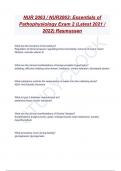NUR 2063 / NUR2063: Essentials of
Pathophysiology Exam 2 (Latest 2021 /
2022) Rasmussen
K
What are the functions of the kidneys?
Regulation of blood pressure; regulating blood osmolarity; removal of toxins; blood
filtration; activate vitamin D
C
LO
What are the clinical manifestations of benign prostatic hypertrophy?
dribbling; difficulty initiating urine stream; hesitancy; urinary retention, decreased stream
YC
What substance controls the reabsorption of water from the collecting ducts?
ADH- Anti Diuretic Hormone
D
What is type 2 diabetes characterized as?
peripheral tissue insulin resistance
U
ST
What are the clinical manifestations of Graves' disease?
Exophthalmos (bulging eyes), goiter, enlarge thyroid, heat intolerance, anxiety-
hyperthyroidism
What processes occur during fasting?
glucogenesis; glycogenesis
,What type of tissue is accessed to promote energy production in type 1 diabetes?
adipose/ fat
What are the clinical manifestations of hypothyroidism?
myxedema, fatigue, cold sensitivity, constipation, weight gain
K
What are the clinical manifestations of hyperthyroidism?
C
Goiter, fatigue, weight loss, infertility, memory loss, hair loss, muscle pain
LO
What are the clinical manifestation of hyper para thyroidism?
fatigue, body aches, bone pain, depression, headaches, memory loss
YC
What are the clinical manifestations of hypo para thyroidism?
numbness, tetany, parathesis, muscle spasms
D
What are the clinical manifestations of ketoacidosis?
U
fruity breath, drowsiness, nausea, thirst, confusion, lethargy, vomiting
ST
What mechanisms control hormone release and regulation?
negative feedback loop
What hormones are released by the anterior pituitary gland?
Growth Hormone, prolactin, follicle stimulating hormone, thyroid stimulating hormone,
LH, ACTH and endorphins
, What is diabetes insipidus?
a disorder caused by inadequate amounts of ADH which causes excessive water loss
clinical manifestations of diabetes insipidus
polyuria, nocturia, continuous thirst, and polydipsia
K
C
clinical manifestations of Cushings syndrome?
Excessive secretion of cortisol causes redistribution of fat, "moon face", "buffalo" hump
on the back and pendulous abdomen. -
LO
Facial skin is flushed (high blood pressure), skin covering abdomen develops stretch
marks - •
ndividual bruises easily and wound healing is poor -
YC
Approximately 1/2 develop mental status changes from irritability to severe psychiatric
disturbance -
Females may experience changes due to increased androgen levels
D
U
clinical manifestations of secondary hypothyroidism
Weakness. -
Fatigue. -
ST
Cold intolerance. -
Constipation. -
Weight gain. -
Depression. -
Joint or muscle pain. -
Brittle fingernails.
clinical manifestations of primary hypothyroidism




